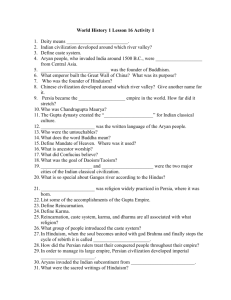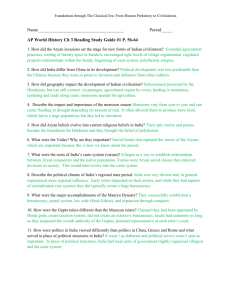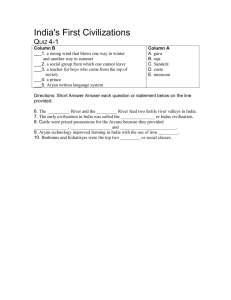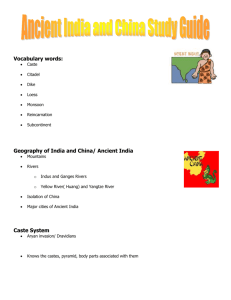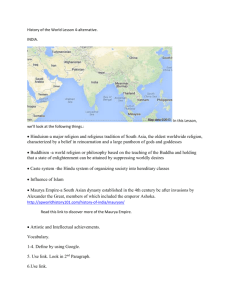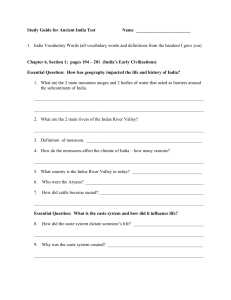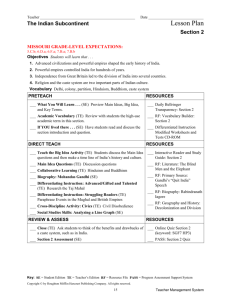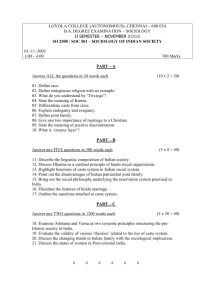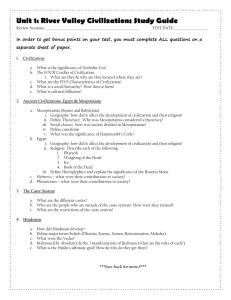Indus River Valley Civilizations Chapter 2
advertisement
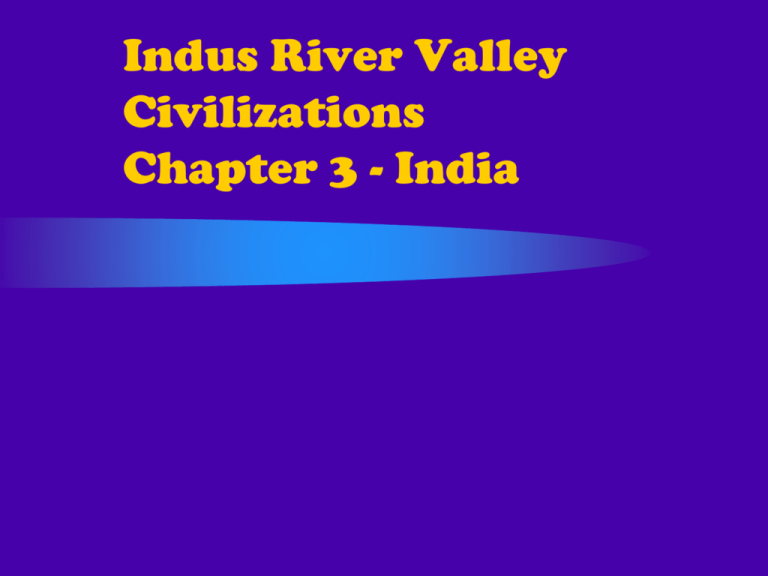
Indus River Valley Civilizations Chapter 3 - India Indus River Valley Civilizations I.) Indus River Valley Civilizations: also known by their two major cities: Harappa and Mohenjo-Daro that established around the fertile Indus River Valley and it became the cradle of Indian civilization. Location and Geography -The Indian subcontinent is shaped like a triangle -The Himalayas are in the north, they are the highest mountains in the world -Right below the mountains is the Ganges River -The dry Indus River valley is to the west, it runs through modern day Pakistan II.) Harappa Civilization: The Harappa was discovered in 1920s by archaeologists, unfortunately their written language (form of pictographic with over 400 symbols) has not been able to be deciphered to little is known about how the people or their government was organized. Recent discoveries believe that the civilization was ruled by a coalition of landlords and rich merchants and not a monarchy or a theocracy. City: The civilization contained small mudbrick villages that covered over 600,000 square miles. The city was surrounded by a brick wall over 40 feet thick and 3 ½ miles in circumference. It was built on a grid pattern and at its height had a population of 80,000 people. The city had neighborhoods of houses that were three stories high and had a courtyard. The houses also had indoor bathrooms. The waste was carried out of the house through a drainage system out to the sewage pits outside the walls of the city. Indus River Valley Civilization Economy: The Harappa Civilization economy was mainly based on agriculture. Their crops consisted of wheat, barley, rice and peas. It is believed that the Harappa civilization is responsible for the introduction of cotton and rice to the area. The Harappa Civilization also had an extensive trading network. Many items from the city of Sumer were found in the city of Harappa. Harappa Culture and their achievements: 1.) The Harappa Civilization was very sophisticated like the Sumerians 2.) Superb pottery created by a pottery wheel and sculptures that showed expression 3.) Domestication of sheep and goats 4.) Widespread trade with other civilizations Decline of the civilization is really unknown but the archaeologists believe that the people were destroyed by the invasion of the Aryan civilization. III.) Aryans: The Aryan people were very warlike people who had a great advantage over others due to their use of iron in their weapons and farming tools. The Aryans used a written language to preserve their traditional stories in the book known as the Rigveda. Government: The Aryan tribes were led by a chieftain known as a raja (prince). The Raja was believed to be a representative from the gods and he was aided by a council of elders. The Chieftain did not have absolute power because the Aryan people believed that everyone including the Chieftain had to follow the dharma which was a set of laws that discussed the level of behavior for all the Aryan society. Caste System: Organization of the Aryan People The Aryan people and their conquered people were organized two ways into their Caste System. One of the ways of dividing people was the color of skin. The Aryan people were light skin and the people they conquered were dark skin. The light skin people were given a higher status than the dark skin conquered people. The second classification for the Caste System was based on their economic function or occupation in the society. Caste System: There were five divisions of caste in the Caste System. At the top would be the priests known as the Brahmins. The priests were connected to Brahman, the top god of the Hindu religion. The second caste was the warriors known as the Kshatriya. They were under the priests but they were the ruling caste for the government. The third class was the merchant caste known as the Vaisya. This group was responsible for the hunt, gathering, farming, and supplying the goods and food for the civilization. The fourth group which contained the largest number of the population was the servant group who performed the manual labor for the other caste, known as the Sudras. Many historians believe that this group was not true Aryans. Caste System: The fifth group in the Caste System was known as the Untouchables. Many believe that this group was not even part of the Caste System. The Untouchables were made up of criminals, ethnic minorities, prisoners of war, and other groups outside the Indian society. The Untouchables did the jobs that no one in the Aryan society would do. These jobs were considered degrading tasks. The Untouchables were considered half humans, they had to live in a different area of the city and they had to announce their presence when they went into the city. The other caste did not socialize with the untouchables. Rules of the Caste System The rules of the Caste System were fairly easy. 1.) Born into the Caste and remain there until death 2.) Marriage was done within the caste 3.) The socialization between castes was very limited Family Life in Ancient India: Family was the basic unit of society Father’s Role: 1.) Oldest male in the family possessed the legal authority over the whole family 2.) Oldest male was responsible for the rituals of the family 3.) Children were the property of the father Treatment of women: Women were inferior 1.) Women could not be priest 2.) Women could not receive any education 3.) Women worked in the home and daughters were considered to be an economic burden 4.) However, women were admired and honored for their talents and this can be seen in the paintings IV.) Religion: Hinduism: The Aryan religion was known as Hinduism and it went hand and hand with the Caste System. The sacred text for the Hindu religion is known as the Vedas. The Vedas is the collection of four books of hymns and religious ceremonies. There are thousands of gods in the Hindu religion. The main god in the religion is known as Brahman. Brahman is made up of three other gods, Vishnu, Brahma and Shiva. These three gods form the Great Trinity or also known as the Hindu triad. Brahma is known as the creator, Vishnu is the preserver of life and Shiva is the destroyer or the transformer. General Description: 1.) 4 holy books,Rig-Veda, Yajur Veda, Sama-Veda and Atharva-Veda written in the Sanskrit language 2.) Must follow the 3 path to reach Moksha-perfection or heaven a.) Path of spiritual insight: meditation b.) Path of works: required to do the daily duties of prayer and rituals c.) Path of loving devotion to Brahman 3.) Cows are a god symbol and are sacred 4.) Worship in Hinduism is not congregational instead it is an individual thing. Rules continued: 5.) Hinduism has a string of 108 rosary beads 6.) Hindus believes that a part of Brahman is in every living thing and therefore every living thing deserves the gentleness and care. The Hindus do not kill living things. 7.) Weddings are arranged by parents and the groom and the bride do not meet until the day of the wedding 8.) Funerals: The dead are not embalmed; instead they are burned at the community burning grounds. The skull of the dead will be crushed after the burning by the oldest male in the family to release the soul for reincarnation. The Hindus believe that if a person has good Karma, they will be reborn in a higher caste of the Caste System and vice versa on their journey to achieve Moksha. 9.) Key terms: a.) Dharma: ultimate moral balance of all things. Dharma is played out in all areas of life, religious, social and family. Dharma is also the law. b.) Karma: the belief that a person experiences the affects of his or her own actions. Karma is the belief that every act or thought has consequences. c.) Samsara: is commonly known as the cycle of reincarnation, life, death and rebirth. 10.) Three main Religious symbols: a.) The Swastika: represents the eternal wheel of life, some believe it protects Hindus from evil spirits and natural disasters. b.) The Lotus: symbolizes the birth of the universe, symbol of the sun c.) The Cow: scared animal which provides milk and butter which are used in rituals of atonement V.) Buddhism: The Middle Path: 1.) History: The founder of Buddhism is Siddhartha Gautama, also known as Buddha, the enlightened one or the awakened one. Siddhartha was a Indian prince who married and began to raise a family. But at the age of 29, he discovered the pain of illness and sickness, death, and the pains of old age. He began to meditate to seek the cure for all human suffering and to teach his knowledge to the public. 2.) Beliefs: a.) Nirvana: the perfect peace in Buddhism b.) must follow the 4 noble truths and the 8 fold path to reach nirvana 4 noble truths: 1.) All human life consist of some suffering 2.) Suffering is caused by the desire of material needs 3.) Renounce these desires and one can overcome suffering and reach nirvana 4.) Nirvana can be reached by following the 8 fold path 8 fold path or the Middle Path: 8 Fold Path also known as the Middle Path: 1.) Renouncing all pleasures and accept the 4 truths 2.) Right aims, renounce all ill feelings toward others 3.) Right speech: speak the truth and no gossip or slander 4.) Right behavior: Golden rule, do not steal, kill, lie or drink alcohol 5.) Right way of earning a living: job must help others and not harm anyone 6.) Right effort: practice self-discipline 7.) Right mindfulness: keep mind alert to avoid the entrance of evil 8.) Right concentration: find one’s inner self-through meditation * a person can reach badhi, which means wisdom Five Precepts: c.) Must follow the five precepts: a.) do not harm any living things b.) do not steal, take only what is given c.) avoid over-stimulation-No caffeine d.) do not say unkind things e.) do not drink alcohol or take any drugs d.) Practices: a.) Buddhist monks can only eat cooked food and they cannot store food. Therefore they must go out into the streets everyday to get food from their followers. Buddhist monks eat only twice a day and their last meal is at 11:00 a.m. b.) Religious written language is known as Pali c.) Religious symbols are known as Mandalas when meditating. These are elaborate designs rich in color and very detailed. They are often circular, containing either portraits of various gods or intricate patterns. e.) Similarities to Hinduism: 1.) Siddhartha believed in the concept of reincarnation and the idea of Karma 2.) Believed in the nonviolence idea to living things f.) Difference from Hinduism: 1.) Rejected the Caste System 2.) Simpler than Hinduism 3.) Truly a philosophy rather than a religion g.) Women’s role: Inferior but treated better than elsewhere in ancient India Achievements of the Indus River Valley People V.) Greatest achievements of people of India were architecture and sculptures, plus they made notable discoveries in astronomy. They charted the movements of the heavenly bodies and recognized the spherical nature of the earth. VI.) Maurya Dynasty: The Mauryas dynasty was developed in the 4th -3rd centuries B.C. The Mauryas dynasty main achievement was the unification of India for the first time and it helped to spread Buddhism across India. The first leader of the Mauryas dynasty was Chandragupta Maurya. He was influenced by Alexander the Great and his army. He seized the throne in 321 B.C. He set off to unify India. VI.) Maurya Dynasty: After his death, his son Bindusara took over the throne. It is believed that he added the land around the Bay of the Bengal and the land near the Arabian Sea to the dynasty’s empire. Bindusara’s son, Ashoka Maurya took over the throne in 272 B.C. He is known as the “great conquer”. He is given the credit of uniting the India except for the extreme south. Later he began to hate all the bloodshed and he converted to Buddhism. VI.) Maurya Dynasty: He wanted to spread the beliefs of Buddhism and he left the Rock Edicts in several places in his empire. In the Rock, he talked about good vs. evil, ideas such as kindness, generosity, truthfulness and purity. Ashoka practiced and preached non-violence. He never attempted to conquer the southern tip of India and he outlawed the slaughtering of animals. After his death the empire began to decline. VII. The Kushan Kingdom and the Silk Road A. 1st century A.D. nomadic warriors established the Kushan Kingdom on what is now Afghanistan B. The Kushans prospered by the trade that went through their country C. Silk Road = approx. 4,000 miles of road that reached from China to Syria D. Given its name because of the luxury items shipped http://www.history.com/shows/mankind-the-story-of-all-ofus/videos/mankind-the-story-of-all-of-us-the-silk-road III. The Kingdoms of the Guptas A. Persian invaders ended the Kushan Kingdom in the 3rd century A.D. The Kingdom of the Guptas became the dominate political force in northern India 1. It created a new age of Indian civilization, especially under its greatest ruler (Chandragupta II) 2. The Gupta Empire prospered principally from mining and trade 3. The Gupta rulers owned gold mines, silver mines, and vast lands 4. They traded salt, cloth, and iron domestically and as far away as China and the Mediterranean 5. The Gupta Empire profited greatly from religious trade with pilgrims C. In the 5th century A.D. invasion by the Huns from the northwest weakened the empire and it finally died out completely by the end of the 7th century VIII. The World of Indian Culture A. India has one of the richest cultures in world history 1. Indian civilization has made contributions in the arts and sciences 2. the Vedas = earliest known Indian literature a). Aryan texts are religious and were originally passed down orally, eventually they were written down in Sanskrit 3. Early Indian architecture flourished during the Mauryan Empire, especially under Asoka a). He wanted to spread the ideas of Buddhism, and so he built many religious structures b). 3 principal religious structures were the pillar, the supta, and the rock chamber 1. Pillars = marked the sites pertinent to the Buddha’s life 2. Suptas = built like burial mounds and held relics of the Buddha 3. Rock Chambers = carved out of mountainsides served as houses for monks and halls for religious ceremonies C. Ancient Indian scientists were most known for astronomy 1. They chartered the movements of the heavenly bodies, recognized the earth was a sphere, and believed rightly that the earth rotated on its axis and revolved around the sun D. Ancient Indian mathematicians were very important 1. Aryabhata = famous Gupta Empire mathematician a). One of the first scientists known to have used algebra The End
